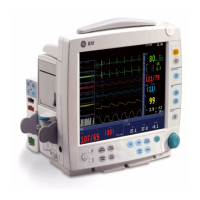B30 Patient Monitor
3-6
Entering and loading patient data
Press the Admit/Discharge key and do one of the following:
− To continue with a patient already admitted on the same monitor, select
Contin.
Previous
.
− To admit a new patient, select
Admit Patient.
The patient admission also happens automatically when the monitor receives vital signs.
Always observe the monitor and the patient carefully during start-up periods and when
inserting modules.
During monitoring
•
If you need to avoid audible alarms, press the Silence Alarms key.
• Empty the water trap container of the N-FCREC or N-FC module whenever it is more than
half full.
Automatic discharge of the patient
The monitor will discharge a patient automatically after 24 hours when vital signs for some
parameters (ECG, Art, NIBP, SpO
2
, Resp and CO
2
(with N-FCREC and N-FC only)) are not
available. When this happens, all trend data will be cleared and alarm limits will be set to
default values.
Ending monitoring
1. Print necessary data.
− Press the
Print/Record key.
2. Wait until the printing is finished. Then clear patient data and return settings, including
alarm limits, to their defaults by discharging the patient:
− Press the
Admit/Discharge key.
− Select Discharge and
Yes.
3. Turn off the monitor from the ON/standby key if the monitor will not be used.
4. Clean the monitor according to the instructions, see section ”Cleaning and care.”
Using modes
The B30 monitor has six user modes. These user modes are predefined combinations of
settings. They determine, for example, what is displayed on the screen and in trends and what
the alarm limits are. In other words, by choosing a specific mode you get suitable settings on
the screen without having to choose all features one by one.
Modes can be hospital specific. The monitor starts in start-up modes, which is one of the user
modes chosen during configuration. The default modes are
STEP-DOWN, ED, PACU, CCU,
NEURO
and PEDIATRIC. Please refer to the “Default Configuration Worksheet“ delivered with
the monitor for more information.
For more information about the installation settings and using modes, see section ”Monitor
setup.”
Setup monitor before use
For more information about the how to setup monitor, see section ”Monitor setup.”

